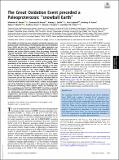Files in this item
The Great Oxidation Event preceded a Paleoproterozoic "snowball Earth"
Item metadata
| dc.contributor.author | Warke, Matthew Robert | |
| dc.contributor.author | Di Rocco, Tommaso | |
| dc.contributor.author | Zerkle, Aubrey Lea | |
| dc.contributor.author | Lepland, Aivo | |
| dc.contributor.author | Prave, Tony | |
| dc.contributor.author | Martin, Adam | |
| dc.contributor.author | Ueno, Yuichiro | |
| dc.contributor.author | Condon, Daniel | |
| dc.contributor.author | Claire, Mark | |
| dc.date.accessioned | 2020-06-02T15:30:03Z | |
| dc.date.available | 2020-06-02T15:30:03Z | |
| dc.date.issued | 2020-06-16 | |
| dc.identifier | 267666661 | |
| dc.identifier | f4dfdb7c-24c1-4f98-a85e-8e5386f96b29 | |
| dc.identifier | 000546040300028 | |
| dc.identifier | 85085651881 | |
| dc.identifier.citation | Warke , M R , Di Rocco , T , Zerkle , A L , Lepland , A , Prave , T , Martin , A , Ueno , Y , Condon , D & Claire , M 2020 , ' The Great Oxidation Event preceded a Paleoproterozoic "snowball Earth" ' , Proceedings of the National Academy of Sciences of the United States of America , vol. 117 , no. 24 , pp. 13314-13320 . https://doi.org/10.1073/pnas.2003090117 | en |
| dc.identifier.issn | 0027-8424 | |
| dc.identifier.other | ORCID: /0000-0002-4614-3774/work/75248339 | |
| dc.identifier.other | ORCID: /0000-0001-9518-089X/work/75248652 | |
| dc.identifier.other | ORCID: /0000-0001-9830-0383/work/75248720 | |
| dc.identifier.other | ORCID: /0000-0003-2324-1619/work/75248767 | |
| dc.identifier.uri | https://hdl.handle.net/10023/20034 | |
| dc.description | This project has received funding from the European Research Council (ERC) under the European Union’s Horizon 2020 research and innovation programme (grant agreement No 678812 to M.C.) | en |
| dc.description.abstract | The inability to resolve the exact temporalrelationship between two pivotal events in Earth history, the Paleoproterozoic Great Oxidation Event (GOE) and the first ‘snowball Earth’ global glaciation, has precluded assessing causality between changing atmospheric composition and ancient climate change. Here we present temporally resolved quadruple sulfurisotope measurements (δ34S, ∆33S and ∆36S)from the Paleoproterozoic Seidorechka and Polisarka Sedimentary Formations on the Fennoscandian Shield, NW Russia, that address this issue. Sulfides in the former preserve evidence of mass-independent fractionation of sulfur isotopes(S-MIF) falling within uncertainty of the Archean Reference Array with a ∆36S/∆33Sslope of -1.8 and have small negative ∆33S values, whereas in the latter mass-dependent fractionation of sulfur isotopes (S-MDF) is evident, with a ∆36S/∆33S slope of -8.8. These trends, combined with geochronological constraints, place the S-MIF/S-MDF transition, the key indicator of the GOE, between 2501.5± 1.7 Ma and 2434 ± 6.6 Ma. These are the tightest temporal and stratigraphic constraints yet for the S-MIF/S-MDF transition and show that its timing in Fennoscandia is consistent with the S-MIF/S-MDF transition in North America and South Africa. Further, the glacigenic part of the Polisarka Formation occurs 60 m above the sedimentary succession containing S-MDF signals. Hence, our findings confirm unambiguously that the S-MIF/S-MDF transition preceded the Paleoproterozoic ‘snowball Earth’. Resolution of this temporal relationship constrains cause-and-effect drivers of Earth’s oxygenation, specifically ruling out conceptual models in which global glaciation precedes or causes the evolution of oxygenic photosynthesis. | |
| dc.format.extent | 7 | |
| dc.format.extent | 1321276 | |
| dc.language.iso | eng | |
| dc.relation.ispartof | Proceedings of the National Academy of Sciences of the United States of America | en |
| dc.subject | Quadruple sulfur isotopes | en |
| dc.subject | Mass independent fractionation | en |
| dc.subject | Great Oxidation Event | en |
| dc.subject | Snowball Earth | en |
| dc.subject | GE Environmental Sciences | en |
| dc.subject | DAS | en |
| dc.subject | BDC | en |
| dc.subject | R2C | en |
| dc.subject | SDG 13 - Climate Action | en |
| dc.subject.lcc | GE | en |
| dc.title | The Great Oxidation Event preceded a Paleoproterozoic "snowball Earth" | en |
| dc.type | Journal article | en |
| dc.contributor.sponsor | European Research Council | en |
| dc.contributor.institution | University of St Andrews. School of Earth & Environmental Sciences | en |
| dc.contributor.institution | University of St Andrews. St Andrews Centre for Exoplanet Science | en |
| dc.contributor.institution | University of St Andrews. St Andrews Isotope Geochemistry | en |
| dc.contributor.institution | University of St Andrews. Marine Alliance for Science & Technology Scotland | en |
| dc.contributor.institution | University of St Andrews. Scottish Oceans Institute | en |
| dc.contributor.institution | University of St Andrews. St Andrews Sustainability Institute | en |
| dc.identifier.doi | 10.1073/pnas.2003090117 | |
| dc.description.status | Peer reviewed | en |
| dc.identifier.grantnumber | 678812 | en |
This item appears in the following Collection(s)
Items in the St Andrews Research Repository are protected by copyright, with all rights reserved, unless otherwise indicated.

